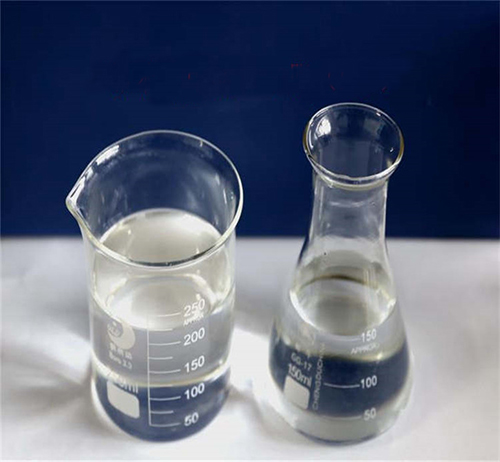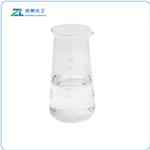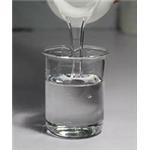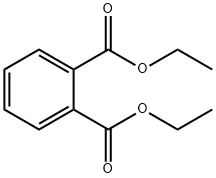Application of diethyl phthalate in production and life
Apr 8,2022
Introduction
Diethyl phthalate is a chemical with the molecular formula C12H14O4[1]. Colorless to slightly yellow clear oily liquid. Soluble in ethanol, ether, soluble in acetone, benzene, carbon tetrachloride, almost insoluble in water. Used as plasticizer, solvent, lubricant, fixative, foaming agent for colored or rare metal mine flotation, gas chromatography fixative, alcohol denaturant, spray insecticide. Store in a cool, ventilated warehouse. Keep away from fire and heat sources. It should be stored separately from oxidants and acids, and should not be mixed. Equipped with the appropriate variety and quantity of fire equipment. Storage areas should be equipped with emergency release equipment and suitable containment materials.

Picture 1 Diethyl phthalate liquid
Application of diethyl phthalate in production and life
Diethyl phthalate is an intermediate of the rodenticides dimouse, murine, and chlorpyrone, and is also an important solvent. Diethyl phthalate is used as a plasticizer for plastics. Diethyl phthalate is used as an analytical reagent, a gas chromatography stationary solution, a solvent for cellulose and esters, a plasticizer and a lubricant. Diethyl phthalate is used as plasticizer, solvent, lubricant, fixative, foaming agent for colored or rare metal mine flotation, gas chromatography fixative, alcohol denaturant, spray insecticide. This product is mixed with cellulose acetate, cellulose acetate butyrate, polyvinyl acetate, nitrocellulose, ethyl cellulose, polymethyl methacrylate, polystyrene, polyvinyl butyral, vinyl chloride-vinyl acetate Most resins such as copolymers have good compatibility. It is mainly used as a plasticizer for cellulose resin, but the product has high volatility, which limits its wide application. The product has low toxicity, and the LD50 of oral administration in rabbits is 1000 mg/kg.
Diethyl phthalate is used as a fixative for fragrances, and can also be used as a plasticizer for alkyd resins, nitrile rubber and neoprene rubber; intermediates for rodenticides Dimox, Muwan, and Chloraurone , is also an important solvent; used as analytical reagents, gas chromatography stationary solutions, solvents, plasticizers and lubricants of cellulose and esters; used as plasticizers, solvents, lubricants, fixatives, colored or rare metals Foaming agent for mine flotation, gas chromatography fixative, alcohol denaturant, spray insecticide. This product is mixed with cellulose acetate, cellulose acetate butyrate, polyvinyl acetate, nitrocellulose, ethyl cellulose, polymethyl methacrylate, polystyrene, polyvinyl butyral, vinyl chloride-vinyl acetate Most resins such as copolymers have good compatibility. It is mainly used as a plasticizer for cellulose resin, but the product has high volatility, which limits its wide application. The product has low toxicity, and the LD50 of oral administration in rabbits is 1000mgkg
Precautions for the use of diethyl phthalate
Closed operation, pay attention to ventilation. Operators must undergo special training and strictly abide by operating procedures. It is recommended that operators wear self-priming filter respirators (half masks), chemical safety goggles, anti-gas permeable work clothes, and rubber oil-resistant gloves. Keep away from fire and heat sources, and smoking is strictly prohibited in the workplace. Use explosion-proof ventilation systems and equipment. Prevent vapors from leaking into the workplace air. Avoid contact with oxidants and acids. When handling, it should be lightly loaded and unloaded to prevent damage to packaging and containers. Equipped with the corresponding variety and quantity of fire fighting equipment and leakage emergency treatment equipment. Empty containers may be harmful residues. Store in a cool, ventilated warehouse. Keep away from fire and heat sources. It should be stored separately from oxidants and acids, and should not be mixed. Equipped with the appropriate variety and quantity of fire equipment. Storage areas should be equipped with emergency release equipment and suitable containment materials.
When diethyl phthalate leaks, quickly evacuate personnel from the leaked contaminated area to a safe area, isolate them, and strictly restrict access. Cut off the source of ignition. It is recommended that emergency personnel wear self-contained positive pressure breathing apparatus and protective clothing. Cut off sources of leaks as much as possible. Prevent flow into restricted spaces such as sewers and flood drains. When a small amount of leakage occurs, absorb it with dry sand or similar substances, or brush it with an emulsion made of a non-combustible dispersant. After the lotion is diluted, it is put into the waste water system. When a large leak occurs, build a dike or dig a pit to contain it. Transfer it to a tanker or a special collector with a pump, and recycle it or transport it to a waste disposal site for disposal.
Reference
1 Zheng Junmin. Handbook of Pharmaceutical Excipients. Beijing: Chemical Industry Press, 2004.7
- Related articles
- Related Qustion
Diethyl phthalate
84-66-2You may like
Diethyl phthalate manufacturers
- Diethyl phthalate
-

- $60.00 / 1kg
- 2024-05-16
- CAS:84-66-2
- Min. Order: 1kg
- Purity: 99
- Supply Ability: 5000
- Diethyl Phthalate DEP
-

- $99.00 / 1kg
- 2024-05-11
- CAS:84-66-2
- Min. Order: 1kg
- Purity: 99%
- Supply Ability: 20ton
- Diethyl phthalate
-

- $6.00 / 1KG
- 2024-04-27
- CAS:84-66-2
- Min. Order: 1KG
- Purity: More than 99%
- Supply Ability: 2000KG/Month




